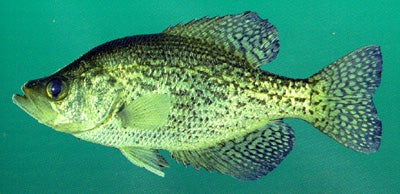SCIENTIFIC NAME: Pomoxis nigromaculatus
CHARACTERISTICS: Three characteristics easily distinguish black and white crappie. Black crappie have seven to eight dorsal spines; white crappie usually have six. The dorsal fin base on black crappie is equal to or slightly longer than the distance from the rear margin of the eye to the origin of the dorsal fin base; the dorsal fin base is shorter on white crappie. Finally, the sides of white crappie have eight to 10 vertical, dark gray reticulated bands that are lacking on black crappie. Other distinguishing characteristics of the black crappie include 35 to 41 lateral line scales, 14 to 16 dorsal rays, five to seven anal spines, and 16 to 19 rays. The back is usually light gray to light lime green. The sides and venter are lime green with a silvery sheen. Dark mottling is scattered across the body. The dorsal, caudal, and anal fins have several alternating light and dark wavy bands. See Cuvier and Valenciennes (1829) for original description.
ADULT SIZE: 12 to 18 in (300 to 460mm).
STATE RECORD:
a list of the State Record Freshwater Fish.
DISTRIBUTION: Black crappie occur naturally from the Mississippi Valley and Great Lakes southward to the Gulf Coast, including Alabama. Their apparent absence in the Escatawpa, Blackwater, and Yellow river systems could be due to insufficient sampling. Introductions have expanded the range of this species westward to the Pacific Coast and northward into Canada.
HABITAT AND BIOLOGY: Pomoxis nigromaculatus occurs in greatest abundance in rivers, reservoirs, and large lakes, although small individuals occasionally enter medium-sized to large streams. Black crappie seem to prefer clearer waters than do white crappie, which could account for the former species’ wider distribution in the upper Coosa and Tallapoosa river systems. Before spawning, black crappie form schools and venture to feed into shallow water, where they are caught in large numbers by anglers using minnows and tiny jigs around heavy cover. Spawning occurs from April into May. Black crappie live for eight years in Reelfoot Lake, Tennessee (Schoffman, 1940).
ORIGINAL DESCRIPTION: Lesueur described the white crappie in 1829.
ETYMOLOGY:
Pomoxis means sharp opercle.
nigromaculatus means black spotted.
The copyrighted information above is from Fishes of Alabama and the Mobile Basin.






